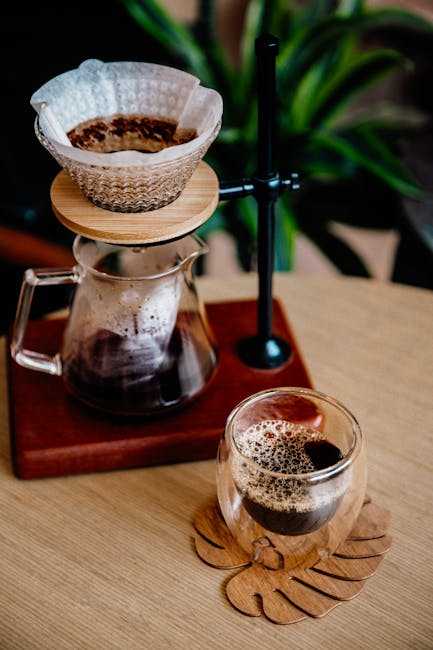French Press vs Pour Over: Which Brewing Method Elevates Your Coffee Game?
Coffee aficionados know that how you brew your coffee can drastically affect its flavor, aroma, and overall experience. Among the myriad of brewing techniques, two methods consistently stand out: the French Press and Pour Over. Each has its fervent advocates and unique characteristics. In this article, we’ll explore the nuances of these two popular brewing methods to help you decide between French Press vs Pour Over: Which Brewing Method Elevates Your Coffee Game?
Understanding the Basics
French Press
The French Press, also known as a press pot or plunger pot, utilizes a simple yet effective mechanism. Ground coffee is steeped in hot water, allowing for maximum extraction of flavors. After a few minutes, a plunger with a metal or nylon mesh filter separates the coffee grounds from the liquid, producing a thick and robust brew.
Pour Over
Pour Over coffee brewing involves pouring hot water over coffee grounds in a filter-lined dripper (like a Chemex or Hario V60) and allows the water to extract flavors as it passes through the grounds. This method provides greater control over variables such as water temperature, pour rate, and time, resulting in a cleaner profile of flavors.
Flavor Profiles
French Press Flavor
One of the most notable traits of the French Press is its full-bodied flavor. Because the coffee grounds are steeped in hot water for several minutes, the resulting brew contains oils and fine particles that enhance richness. If you enjoy a stronger cup of coffee that hits you with depth and a lingering finish, the French Press may be your go-to method.
Pour Over Flavor
On the other hand, Pour Over tends to deliver a cleaner, brighter, and more nuanced coffee experience. This method allows for a more controlled extraction process, minimizing bitterness and excess oils. Pour Over brews bring forth delicate flavors and aroma intricacies, making it ideal for single-origin coffees or lighter roasts.
Brewing Process
French Press Method
Brewing with a French Press is straightforward:
- Coarse Grind: Use a coarse grind for coffee beans (approximately 1:15 coffee-to-water ratio).
- Add Water: Add hot water (just off the boil) and let it steep for about 4 minutes.
- Plunge: Slowly press the plunger down to separate the grounds from the coffee.
- Serve: Pour and enjoy your thick, full-bodied cup!
Pour Over Method
The Pour Over process can be a bit more intricate:
- Medium-Fine Grind: Use a medium-fine grind for the coffee (again, a 1:15 ratio works well).
- Pre-Wet the Filter: Rinse the coffee filter in hot water to eliminate paper taste and warm your dripper.
- Add Coffee: Place the ground coffee in the filter and make a small well in the center.
- Bloom: Pour a small amount of hot water over the coffee and let it bloom for 30 seconds.
- Pour Slowly: Gradually pour the rest of the water in a spiral motion, allowing it to drip through.
- Serve: Once the water has completely passed through, serve and savor your clear, rich cup!
Cleanup
When it comes to cleanup, the French Press is a bit more hands-on. After brewing, you need to disassemble the press and rinse the components, including the filter mesh, which can collect coffee oils. This method may require more effort to ensure all grounds are removed.
Conversely, the Pour Over method requires the disposal of the paper filter. Simply remove the filter, discard the grounds, and rinse the dripper. Cleanup can be quicker and tidier than using a French Press.
Time Investment
Brewing time is another critical aspect to consider. The French Press allows you to enjoy a cup of coffee in about 5–7 minutes (including steeping time). The Pour Over method may take longer due to the controlled process, typically around 4–5 minutes for the actual pour, plus blooming and setup, making the total time closer to 6–8 minutes.
FAQ Section
Q: Is the French Press bad for you?
A: While some studies suggest that the oils from coffee can impact cholesterol levels, moderate consumption of French Press coffee is generally considered safe for most people.
Q: Can I make espresso in a French Press?
A: No, a French Press does not produce espresso, as espresso requires high pressure and finely ground coffee.
Q: Which method is more environmentally friendly?
A: Pour Over can be more eco-friendly when using reusable filters or drippers. French Press also has minimal waste, but its filter requires more cleaning.
Q: Which brewing method has a faster learning curve?
A: French Press is typically easier for beginners due to its straightforward process, while Pour Over involves more variables that require practice to master.
Conclusion
When it boils down to French Press vs Pour Over: Which Brewing Method Elevates Your Coffee Game? the answer largely depends on your personal taste and brewing preferences. If you seek a bold, rich cup with complex profiles, you may lean towards the French Press. However, if you appreciate a brighter, cleaner coffee experience with greater flavor clarity, the Pour Over method might be your best bet.
Whichever method you choose, the key is to experiment, have fun, and enjoy the process of making coffee. After all, it’s not just about the end product; it’s about the journey of discovering the ideal cup that speaks to your palate. So, grab your beans, get brewing, and elevate your coffee game!


